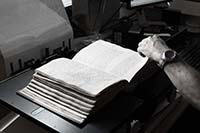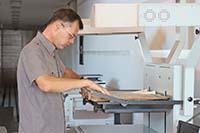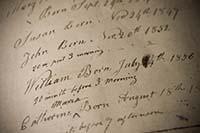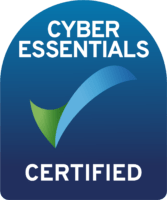Once you’ve agreed your capture process and completed a test, it’s time to start image capture and adding your metadata. Organising this process is crucial.
Digitisation is the process of creating digital versions (or surrogates) of your original materials and linking it to metadata which describes your items. The digitised images, audio, or video files are important but the metadata which enables them to be found is even more crucial.
It is important that you don’t get overly distracted by the scanning, image capture or digitisation of your items as this only represents about 5-10% of the challenge. Creating effective metadata is the lion share of the task and will result in your content being searchable and useful to your users.
Here are a few areas to consider:
Colour Calibration and Image Quality
The idea with image capture in particular is to; ‘Do it once and do it right’. Essentially this means that in order to protect your items you should aim to handle them as little as possible. If you are going to digitise an item therefore, try to do it to the best quality you can afford to so that you reduce the likelihood of having to digitise it again in the future.
Different sized institutions have varying levels of purchasing power for equipment or services. In trying to get the best quality therefore, just work within the budget that you have available.
Colour calibration and getting a high quality image in terms of resolution is important if you can do it because it means that your images are as faithful a representation of the original item as possible. Don’t worry though if you can’t afford a scanner worth thousands, entry level scanners or cameras can generate good enough results to at least give your users access to your collections online.
Capture workflow
Before you start to capture images don’t forget to consider the conservation and condition of your items. Will digitisation damage them at all? Is there a risk? Choosing the correct capture methodology that is appropriate for the original items is an important consideration.
In terms of efficiency, it might make sense to group all items of a particular format and size together to digitise as a batch. This will enable you to digitise in a more consistent and efficient way.
Consider where the items are stored, would it be easier and safer to digitise the items in their storage location as opposed to moving them?
Quality Assessment
We are of the belief that you should build in quality checking at every step in the process. It is simply more efficient that way. Consider that if you check the images captured and spot a problem, it is much easier to rescan when you are still doing the digitisation than having to go back weeks later when all the equipment has been put away and the items are back in store.
Don’t forget to test the testers too!
Metadata
Metadata means, literally ‘data about data’. If you simply digitise and upload your content with a filename then your users will never be able to find it as the filename is pretty meaningless. Metadata fields for title, description, locations, dates, featured persons, subject tags etc. all add to a high searching and browsing experience for your users.
We strongly recommend using internationally accepted and open source metadata schemas (formats) for your metadata. Formats such as METS, Dublin Core, MARC21, EAD and others. These protect your data in the long term and also make your data easily searchable by the systems of other institutions.
OCR
OCR, or Optical Character Recognition is the process by which a computer system ‘reads’ printed text characters and makes the document searchable by your users. It is pretty accurate (around 96% accurate or higher) if the images are of a good quality. OCR is a useful addition to metadata about your digitised items but it should not be seen as a replacement in our opinion.
If your items are largely printed text based or type written then OCR is certainly something worth considering. Remember though that OCR does not work on handwritten text!
If you’d like to chat through any of these aspects then please get in touch and we’d be happy to help.





